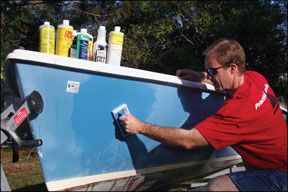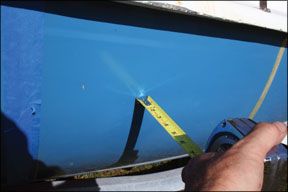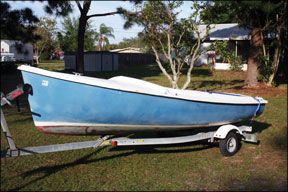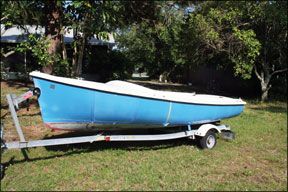
288
Acrylic fiberglass coatings—an alternative when waxes and polishes won’t revive your gelcoat—leave a hard, clear plastic coating on gelcoat. The last time we tested them, there were only a few products on the market, including Lovett Marine’s Vertglas, Poli Glow, and NuGlass 2.
After Practical Sailor testers applied these coatings on a 21-foot powerboat in 2004 (April 1, 2004 issue), we recommended those that were the easiest to work with: Vertglas and Poli Glow.
The shine quality was about equal, and all of the coatings held up well for a couple of years. But after the third season, two of the three—Vertglas and NuGlass2—began to fail, leaving Poli Glow as our top dog (May 1, 2007 issue). Mind you, these acrylic coatings are supposed to be reapplied every one to two years, so our multiple-year test was extreme.
Acrylics vs. Wax/Polishes
So what’s the difference between acrylic coatings and conventional waxes and polishes?
Waxes and polishes fill in minor surface imperfections and give the gelcoat a reflective surface.
Waxes stick to the surface because they are tacky and require lots of elbow grease to get them to crystallize and take on a shiny appearance. Buffing smooths out the surface and forces the wax into any depression in the surface. Because waxes are simply clinging to the boat’s surface, they wear off fairly quickly.
Polishes, sometimes called synthetic waxes, are typically based on polymer technology, which means they actually bond to the boat’s surface. While curing, polymers creep into depressions. Polishes typically last longer and resist weathering better than pure waxes.
In our opinion, acrylic coatings should be used only when the boat’s surface is so deteriorated that waxes and/or polishes will no longer provide a shiny result.
With acrylic coatings, multiple thin coatings are required to provide a smooth overall finish (similar to painting). Acrylics bond to the surface and are very resistant to abrasion, weathering, and chemical attack. They do eventually wear off, and another application of the coating will bring back the shiny surface.
What We Tested
We rounded up seven products from as many manufacturers. New to our tests were Star brite Glass Cote, Klasse High Gloss Sealant Glaze, Higley FiberGloss Restorer, and Presto Gelcoat Rejuvenator.

288
Some restorer products are sold as part of a complete kit, while others are just one bottle. For instance, Vertglas includes a heavy-duty oxidation remover, a boat wash, a restorer/sealer, and a cleaner to remove the restorer/sealer. Star brite Glass Cote is sold solo, with no applicators and with the directions right on the bottle.
Three of the seven makers provided applicators—Vertglas, Poli Glow, and NewGlass2. (Note the name change from NuGlass2.) The kits for these also come with a pre-treatment cleaner. A couple of the other manufacturers sell cleaners separately.
All of these products require five to eight coats to fill all imperfections and then build up an even sheen.
These products must be reapplied annually or at least every two years. The more weather—especially sunlight—they endure, the quicker they wear. Poli Glow, in fact, recommends reapplying at the six- to eight-month mark in tropical climates.
Readers have reported that acrylic coatings tend to peel or turn yellow over time. In our previous long-term test, Practical Sailor did not notice peeling until well past the claimed life of the coating. No yellowing was noted.
Another issue raised in reader letters is the effect marine cleaners have on acrylic coatings—namely Spray Nine on Vertglas. So, we sprayed Spray Nine on the Vertglas-covered portions of a test boat. We didn’t note any problems, but we suggest using only manufacturer-recommended cleaners on finished surfaces.
How We Tested
Acrylic products must be applied according to directions. No winging it.
Instructions generally tell users to apply numerous thin coats in different directions to avoid streaks and brush marks. If heavy coats are applied, the result is a wavy, streaked finish that is not very attractive.
Surface preparation will make or break this maintenance endeavor—no matter which product you choose. You must remove all streaks, scuffs, stains, and oxidation before applying the restorers/finishes. Otherwise, you will seal in the imperfections and then endure looking at a scarred gelcoat until you decide to remove the restorer—not an easy job.
For a test subject, testers turned to the smallest—but most gelcoat-challenged—vessel in the Practical Sailor fleet. Our 1974 O’Day Javelin’s highly oxidized blue gelcoat was pushing the limits of these products—it was probably a better candidate for a paint job. But the oxidation was consistently spread from bow to stern, and in the end, testers were happy with the job done by the top performers—and it was easier than painting it.
The test was simple: Follow the directions. Rate the directions, the ease of use (which includes whether applicators are included), and the shine quality. As always, price was factored into the final equation. Look for six-month updates on these products’ performances in our long-term evaluation.

288
What We Found
Practical Sailor testers were surprised in the difference in shine quality among the seven test products. Ease of use really depended on the applicator.
The quality of directions also varied. With these products, directions loom large, because if you don’t do it right the first time, you’ll face a lot of headache later.
Poli Glow and Vertglas provide the most effective cleaners and/or de-oxidizers, in the Practical Sailor prep crew’s opinion. However, even these top-rated cleaners did not remove all of the oxidation on the first try.
If oxidation remains, these manufacturers recommend wet sanding. What about a rubbing compound? Poli Glow directions say “do not use rubbing or polishing compounds to clean boat.”
Poli Glow owner Howard Marsch explained: “They may leave a residue of oil that interferes with the application of coatings so that it won’t adhere to the gelcoat. Scrub a little harder and use wet/dry sandpaper, 600 grit.”
Vertglas’ expert—Tracy Ritze, manager of Lovett Marine, which sells Vertglas—said using a rubbing compound is OK, but that it must not contain any silicones or waxes. He also recommends wet sanding.
In the end, we decided not to wet sand as we wanted to see how each product performed on its own. For products that did not come with a cleaner, we used Davis FSR, one of the top performing gels in our most recent hull cleaners test (November 2007).
We applied seven coats of each product to a port-side section of the Javelin hull. The top four finishers in the shine-quality test advanced to the final showdown and were applied to sections of the starboard hull.
One of the drawbacks of acrylic coatings is that they are hard to remove. That’s why some of the manufacturers—Vertglas, Poli Glow, and NewGlass2—offer their own removers. Practical Sailor tried these three on the bow of a powerboat coated with Poli Glow’s acrylic coating. The Poli Glow Poli Prep worked best, removing all of the coating. The Vertglas remover left some streaks of the coating, and NewGlass2’s PreTreat left behind more than it removed.
Further testing is required to reach any firm conclusions about the cleaners. Practical Sailor will try the cleaners on the treated sections of the Javelin following the longevity test.
NewGlass2
As we pointed out in the May 2007 article, NewGlass2 is under new ownership. Thom Goff has upped the product’s acrylic solids count—the stuff that makes the hull shiny—by 10 percent over the old stuff, which was called NuGlass 2. The applicator, labeling, and directions have been improved, and the company now offers a cleanser (Pre-Treat) to prep the area to be restored. Pre-Treat can also remove previous acrylic coatings.

288
NewGlass2 was one of the more expensive products tested ($53). The directions are thorough, but testers found that the PreTreat did not work as well as the heavier-duty cleaners from Vertglas and Poli Glow. The applicator, a cylindrical sponge covered with a no-lint cloth, is a bit small and slightly difficult to work with, testers reported. The kit, along with the cleaner and applicator, also comes with rubber gloves.
The NewGlass2 made it to the second round. Testers gave it a Good for a shine rating in both rounds.
Bottom line: Practical Sailor recommends NewGlass2. It was a solid performer in all testing and rating areas. We would like to see a more effective cleaner provided in its kit.
Star brite Glass Cote
Star brite sells this product as a standalone for $28—the second-lowest price in our group. The directions failed to give specific information, including the number of coats to apply. Star brite’s Jeff Tieger explained that the directions are vague because every boat varies in porosity. A five-year-old boat requires fewer coats than our test boat as it is less porous.
As the directions instructed, testers applied the product with a lint-free rag, coating the hull section seven times. Glass Cote went on in extremely thin layers and didn’t build up as well as some of the other products, according to testers.
Tieger said, “We deliberately thin out our Glass Cote so multiple coats are required … If the manufacturer makes the product too thick, it will look shiny with very few coats, but the chances for brush marks are much greater.”
Glass Cote provided a minimal shine to its section. It did not advance to the second round. Tieger pointed out that our old hull needed 10-12 coats, so expect a followup report.
Bottom line: The Glass Cote is relatively expensive, and it failed to provide a shine on the same level as some of the other products.
Poli Glow
The winner of our last test and the second most expensive product in our group, Poli Glow comes with just about everything you need for the project—Poli Prep Cleaner, Poli Glow restorer, a 3-by-6.5-inch PVC applicator with pole-threaded attachment, a 3-by-6.5-inch sponge applicator, and a 3.25-by-2-inch cloth applicator.
The Poli Prep was not effective during this test. As an alternative, Poli Glow recommends its PoliOx ($8), a hull cleaner that is not included in the kit. Testers found that it removed the oxidation very well.
The Poli Glow directions were better than most other products. Having two different-size applicators made the application process easier. The large one allowed testers to cover ground quickly, while the smaller one was good for tight spots.

288
Poli Glow delivered an impressive shine. Its section of gelcoat looked slightly better than the NewGlass2.
Bottom line: The Poli Glow is an expensive product, but you get a lot for your money, and it was among the top three finishers in the initial gloss test.
Klasse Sealant Glaze
New to this test, the Klasse product is sold in a 17-ounce bottle. Its target market appears to be automotive, although it does refer to boats in its labeling. Imported from Germany by a San Francisco company, Klasse is available on several websites, including www.autogeek.com.
The least expensive product tested, it comes with only the restorer, no cleaners or applicators. The company does offer a cleaner though, Klasse All-in-One Cleaner Protector.
Testers found Klasse’s directions lacking. The instructions were simply “apply extremely thin film (about 2 fl. oz. per car) on … dry surface with soft cotton cloth. Allow to dry, then wipe off with dry cloth.”
A single coat did virtually nothing, so we applied six more. With a full seven coats, its section of gelcoat improved somewhat but fell short of some of the other products.
Bottom line: The product is inexpensive but seems to us to be geared more toward cars. It did not do well in our gloss test.
Vertglas
Made by Lovett Marine—which also makes bilge and sump pumps—Vertglas is a complete kit, with four products, a scrubbing pad with handle, and a 4-by-2.75-inch applicator with a 4-inch handle. None of the other test applicators had handles, which often left testers with restorer all over gloved hands.
The bottles are labeled 1 through 4 to avoid confusion, and the directions are excellent, thorough, and clear.
The Vertglas cleaner—called Oxidation Remover—worked as well as the PoliOx, leaving only a trace amount of oxidation on its section. The provided applicator was easy to work with, and just the right size (about as big as a large paint brush), testers reported. The Vertglas provided the best shine of any product in the first round of testing. It also did well in the second round.
At $67, Vertglas is the priciest product tested.
Bottom line: The Vertglas showed a slight edge over Poli Glow in the gloss test. The Vertglas kit includes a heavy-duty oxidation remover and cleaner, as well as a product to remove the acrylic coating.
Higley Fibergloss
The Higley product comes in a 32-ounce container priced at $30. The company also sells a cleaner, called FiberPrep Cleaner, separately.
The directions were thorough, with specifics about preparation, the number of coats, and drying time.

288
Application was hampered by the open-mouth bottle, which made it hard to pour controlled amounts onto the applicator. The product does not come with an applicator.
The Higley restorer failed to make it to the second round of testing.
Bottom line: Applying the product is harder than others tested, and it did not score well in the shine test.
Presto Rejuvenator
This is a completely different product than the others tested. It requires only one coat. The Gelcoat Rejuvenator works with UV rays to cure and harden. Rather than applying thin coats, either side-to-side or up-and-down, you briskly rub on the product in circular motions and spread it until the surface does not streak.
The bottle warns the user to immediately put the cap back on the container because the sun will start to harden the liquid inside. You must apply it when temperatures are above 55 degrees. You should not apply it in direct sunlight, or it will cure too quickly and become hot.
There are a lot of steps where things can wrong with this product, in our view. And it’s expensive—$35 for a 2-ounce bottle.
The company makes a prep cleaner, called Presto Cleaner. Like its restorer, this stuff is unique. You spray it on, let it foam up, let it stand, and become “agitated,” and spray it off. It worked almost as well as the PoliOx and Vertglas Oxidation Remover.
The Rejuvenator also worked well. Presto gave its section a nice, new-looking shine, and it graduated to the second round of testing, where it also scored well.
Bottom line: The product worked well (as did its cleaner), but it’s tricky to work with. We’ll see how long it lasts.
Conclusion
Vertglas worked best in Round 1 of the test. None of the products—between Vertglas, Poli Glow, NewGlass2, and Presto—stood above the others in the second test. They all provided a good shine.
We can easily recommend Poli Glow and NewGlass2. Both scored well in the shine test. The edge goes to Poli Glow due to its better applicators and more effective cleaner. But the NewGlass2, at $12 less, earns Budget Buy honors.
At this stage in the testing, Vertglas is our Best Choice for application and initial shine. It comes with an effective cleaner and easy-to-use applicator. Vertglas is expensive, but we think it’s worth the money.
Stay tuned for the results of the longevity tests.









































I have also used Poli Glow, very satisfied with it. This stuff works and will make the surface looks new. Just make sure that the surface is clean before the application and you will have the best gel coat surface for a long time.
While seemingly limited in its effectiveness, the starbrite gelcoat restorer works exceptionally well while not cutting into the gel coat. It performs well in restoring gel coats and is ideal for fiberglass hulls.
The polish is fully capable of removing moderate levels of oxidation, including water spots and light scratches. The resulting finish also comes with lasting protection courtesy of the polish and wax protecting from boating elements.